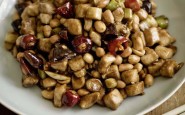Spare ribs in sweet and sour sauce
During the four thousand years or so of known Chinese history, the Imperial capital has always been in the northern parts of the country – with the exception of a few brief periods, notably during the Song dynasty when it was at Hangzhou (1127-1279), and the Ming dynasty when it was at Nanjin (Nanking) (1368-1402). The Chinese Emperor was supposed to be the Son of Heaven, and he lived a very enclosed life inside the Imperial Court, which was known as the ‘Great Within’; he was entirely isolated from the people of the nation. He seldom ventured out of the Forbidden City at all, and never visited the other parts of his vast empire – except when he was driven out by foreign invasion or rebellion, which happened now and again during the course of history.
It was Emperor Ch’ien Lung (1735-95), one of the most distinguished ‘cultured’ Emperors of the Qing (Manchu) dynasty, who, while making an extensive tour of southern China, broke the ancient tradition by disguising himself as an ordinary citizen and going out without his entourage to mingle with the people in the streets. This was quite unprecedented and soon became a legend. One of the most popular stories told at the time was that Ch’ien Lung was most amazed by the discovery of the simple but delicious food eaten by his subjects, as opposed to the rich and elaborately prepared feasts he was served all the year round at the court. When he returned to Peking he ordered the Imperial cooks to prepare for him the simple dishes he had enjoyed at the food stores by the roadside; but alas, the ‘simple’ dishes prepared in the Imperial kitchens no longer had that magical taste he had first experienced.
In a way we have all had similar surprises and disappointments in our own lives. How many times have we heard people complain that a certain wonderful wine they have discovered in the hot sun of the Mediterranean countries never tastes the same back home, and very often people remember certain foods they had in their childhood but somehow can never recapture the flavour in different surroundings. I remember the thrill and excitement of my first encounter with sweet and sour spareribs in a Cantonese restaurant, but I have never tasted anything like them since. No matter how hard I have tried, using a number of different recipes, the results have always beeen the same – good enough for most people, but never with that original je ne sais quoi.
It is pork spareribs that you use for this recipe; the cut is sometimes known as Chinese or American spareribs in Britain, since the English sparerib is a quite different cut.
1 lb (450 g) pork spareribs
1/2 tsp salt
1/2 tsp crushed Sichuan pepper (optional)
1 tsp sugar
1 tbsp brandy or rum
1 egg yolk
1 tbsp cornflour
1 small green pepper, thinly shredded
about 1 pt (600 ml) oil for deep-frying
For the sauce
2 tbsp wine vinegar
2 tbsp sugar
1 tbsp soy sauce
1 tsp cornflour
2 fl oz (50 ml) stock or water
Method
Ideally, each individual rib should be chopped into 2 or 3 small bite-size pieces. If you do not possess a cleaver, ask your butcher to chop the ribs for you.
Marinate the spareribs in salt, pepper, sugar and brandy for at least 15-20 minutes. Meanwhile, make a thin batter by blending the egg yolk and cornflour with a little water. Coat each rib with the batter and deep-fry in hottish oil until crisp and golden. Scoop them out with a perforated spoon or strainer, and heat up the oil to boiling, then fry the spareribs once more – this time not too long, just enough to darken the colour a little.
Pour off the excess oil, leaving about 2 teaspoons. Stir-fry the thinly shredded green pepper for a few seconds, then add the vinegar, sugar, soy sauce and stock or water together with the cornflour for thickening. When this starts bubbling, blend in the spareribs, mixing and tossing to make sure that each piece of the spareribs is coated with the sauce. Serve immediately.
You will find this dish quite different from what you are normally served in a run-of-the-mill Chinese restaurant. When cooked properly, the sauce should be bright and translucent, not too sweet and not too sharp. To add a little more contrast to the colour scheme you can use half a green and half a red pepper.
© Deh-Ta Hsiung and reproduced with his kind permission.


